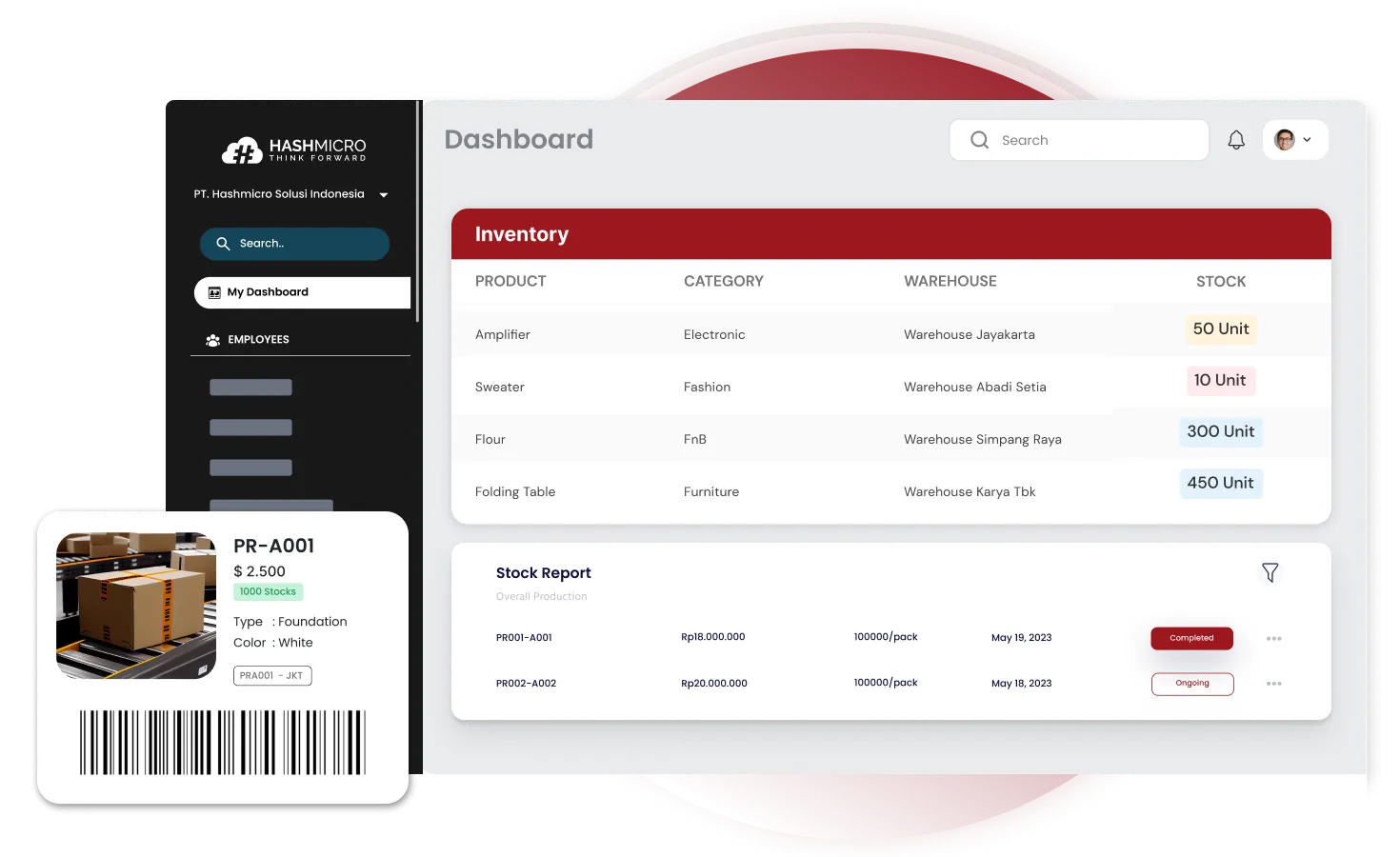Unexpected stockouts, excess inventory and inconsistent demand patterns often point to a critical yet underestimated issue in retail supply chain management, known as the bullwhip effect.
This phenomenon refers to the growing distortion of demand signals as they move up the supply chain from customers to manufacturers, which often results in operational inefficiencies and increased costs.
This article will guide you through the root causes of the bullwhip effect, its impact on supply chain performance, and how your business can mitigate its impact by utilizing strategies such as real-time data analysis, demand forecasting, and Advanced Planning and Scheduling (APS) systems.
Discover how HashMicro’s supply chain management solution enhances visibility and coordination, enabling your operations to remain responsive and efficient.
Key Takeaways
|

What is the Bullwhip Effect?
The bullwhip effect is a common phenomenon in supply chains, where small shifts in customer demand lead to increasingly larger changes in orders placed at each step of the supply chain.
It typically starts with retailers who respond to demand changes by adjusting their orders, which then causes wholesalers, distributors, and manufacturers to do the same often with even greater adjustments.
The result is a chain reaction of overproduction, excess inventory, delayed deliveries, or even shortages. A lack of real-time data, poor communication, and disconnected planning processes across the supply chain often causes the bullwhip effect.
Causes of the Bullwhip Effect
The bullwhip effect is driven by several key factors that disrupt the accurate alignment of supply and demand throughout the supply chain.
1. Demand forecasting
Rather than relying on real-time data, each level of the supply chain typically bases its decisions on projected demand. Retailers, distributors, and manufacturers adjust their orders based on forecasts, which can lead to over- or underestimations that grow larger as they move up the chain.
2. Order batching
To minimize ordering costs, companies often opt to place bulk orders instead of ordering in smaller, more frequent amounts. These large, infrequent orders create sudden demand spikes that disrupt supplier planning and production schedules.
3. Price fluctuations
Special promotions, discounts, or bulk-buying incentives can prompt companies to make unusually large purchases during specific periods. This irregular purchasing behavior disturbs the normal flow of goods and contributes to greater demand variability across the supply chain.
4. Limited communication
A lack of transparency and coordination between supply chain partners causes each party to make decisions in isolation, resulting in suboptimal outcomes. Without shared access to actual sales or inventory data, these decisions are often based on assumptions that distort demand signals.
5. Lead time delays
Extended lead times make it more challenging for businesses to respond quickly to actual demand. To avoid running out of stock, they may inflate their orders as a buffer, unintentionally causing excessive demand upstream.
How the Bullwhip Effect Affects the Supply Chain
The bullwhip effect poses major challenges across the supply chain which disrupts efficiency, increasing costs, and affecting service levels. Below are some of the key impacts it has on supply chain management performance.
1. Inventory issues
When demand signals become distorted, businesses often end up with either excessive stock or insufficient stock. Excess inventory ties up storage space and increases holding costs, while shortages can lead to missed sales opportunities and unhappy customers.
2. Rising operational expenses
Unstable demand patterns necessitate frequent adjustments to companies’ production and delivery plans. These sudden changes often lead to higher labor costs, rushed shipments, and inefficient use of equipment and materials.
3. Unreliable demand forecasts
As each part of the supply chain responds to incomplete or inaccurate information, predicting future demand becomes more difficult. These inaccuracies can disrupt planning and make it harder to maintain a steady supply flow.
4. Supplier pressure
Inconsistent order volumes can overwhelm suppliers, especially when large, last-minute orders occur. This often results in delays, tension in supplier relationships, and challenges in maintaining reliable partnerships.
5. Lower customer satisfaction
When businesses overestimate or underestimate demand, customers may encounter empty shelves or lengthy wait times for orders. Repeated delivery issues or product unavailability can reduce trust and lead customers to seek more reliable alternatives.

How to Prevent the Bullwhip Effect
Minimizing the bullwhip effect requires a strategic and forward-thinking approach to managing demand fluctuations and enhancing communication throughout the supply chain. Below are key strategies that supply chain managers can implement to reduce their impact.
1. Leverage real-time data for smarter forecasting
Integrating real-time data into your demand planning process helps improve forecast accuracy by reflecting current market conditions, not just past trends. This enables businesses to react promptly to actual demand, minimizing the chances of overstocking or running out of products.
2. Strengthen communication and collaboration
Building stronger communication and coordination among all supply chain partners from retailers to suppliers, helps ensure everyone works from the same set of demand data. With shared access to reliable information, businesses can reduce misalignment and avoid unnecessary order fluctuations.
3. Shift to demand-driven replenishment
Moving away from traditional forecasting methods, a demand-driven approach adjusts inventory levels based on actual sales and consumption patterns. This strategy supports a more balanced inventory flow and helps prevent disruptions caused by inaccurate predictions.
How HashMicro Helps You Minimize the Bullwhip Effect with Smarter Supply Chain Solutions
Managing the bullwhip effect requires more than simply recognizing the issue. It calls for a robust, integrated system that enhances visibility, improves forecasting accuracy, and strengthens coordination across all levels of the supply chain.
As a leading retail supply chain management software, HashMicro offers a comprehensive solution tailored to meet these challenges.
By providing real-time data and intelligent automation, HashMicro enables businesses to respond to actual demand instead of relying on assumptions. This approach helps reduce the risk of demand fluctuations, inventory imbalances, and operational inefficiencies often caused by the bullwhip effect.
Here’s how HashMicro’s smart supply chain features make a difference:
- Inventory management: Provides real-time visibility into stock levels across all locations, helping prevent both overstocking and stockouts. Accurate inventory data ensures that replenishment is based on actual consumption, not inflated forecasts.
- Procurement management: Automates and standardizes purchasing processes to maintain consistent order volumes. This minimizes sudden spikes in procurement that can lead to miscommunication with suppliers and disrupt the supply chain flow.
- Order management: Ensures accurate and timely processing of sales and purchase orders. By centralizing order data, businesses can better match supply with true demand and reduce variability caused by delayed or duplicated orders.
- Shipment tracking: Enables businesses to monitor deliveries in real time, improving lead time visibility. With accurate shipment updates, companies can plan inventory and production schedules more reliably.
- Return management: Handles returned goods efficiently and transparently, allowing businesses to adjust inventory levels quickly and reduce uncertainty caused by reverse logistics.
- Planning & forecasting: Uses AI-powered tools to generate accurate demand forecasts based on real-time data, historical trends, and market insights. This helps reduce guesswork and supports more stable, demand-driven supply chain planning.
Conclusion
The bullwhip effect can create significant challenges in supply chain operations, often resulting in excess inventory, weakened supplier relationships, and missed revenue opportunities. Common causes such as inaccurate demand forecasting, bulk ordering, and limited communication can significantly disrupt supply chain efficiency.
HashMicro’s Supply Chain Management software provides a comprehensive solution by enhancing real-time demand visibility, streamlining inventory control, and fostering stronger collaboration with suppliers. With advanced forecasting capabilities and centralized communication tools, businesses can reduce the impact of the bullwhip effect and strengthen supply chain performance.
To explore how these tools can benefit your business, you can request a free demo and experience them firsthand.

FAQ Bullwhip Effect
-
What is a simple example of the bullwhip effect?
In our final Bullwhip Effect example, the retailer launches a limited-time promotion, which spikes beer sales. However, the wholesaler misinterprets this temporary surge as a permanent increase in demand, resulting in an overestimated order to the brewery and an eventual inventory pile-up.
-
Is bullwhip effect good or bad?
Bullwhip effects can lead to excess inventory, lost revenue, and overinvestment in production.
-
Who is most affected by bullwhip effect?
The bullwhip effect is a phenomenon that occurs in supply chain management. Small changes in consumer demand at the retail level lead to much more significant fluctuations in need at the manufacturer and supplier levels. Orders placed by retailers to suppliers fluctuate more extensively than the sales to customers.




























